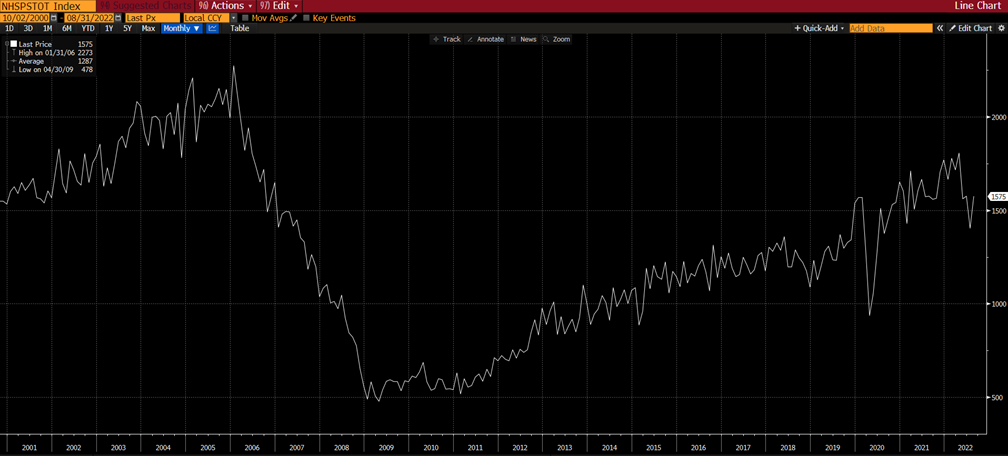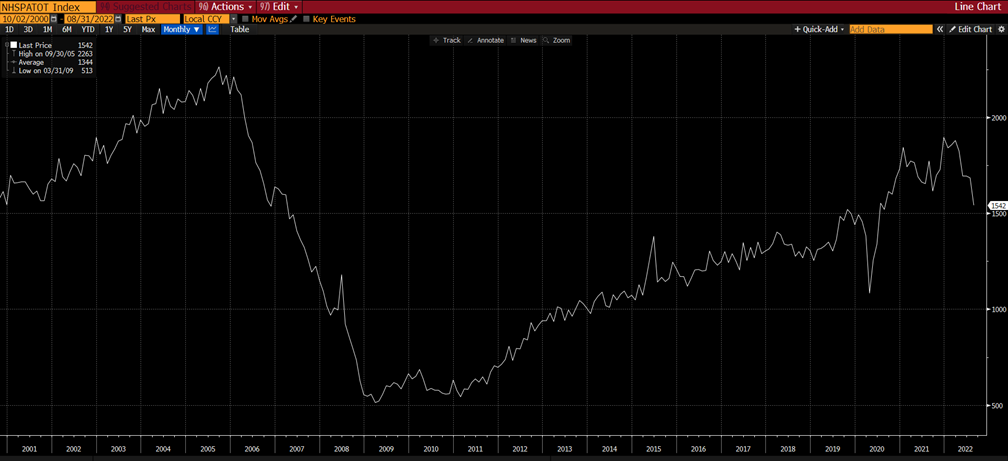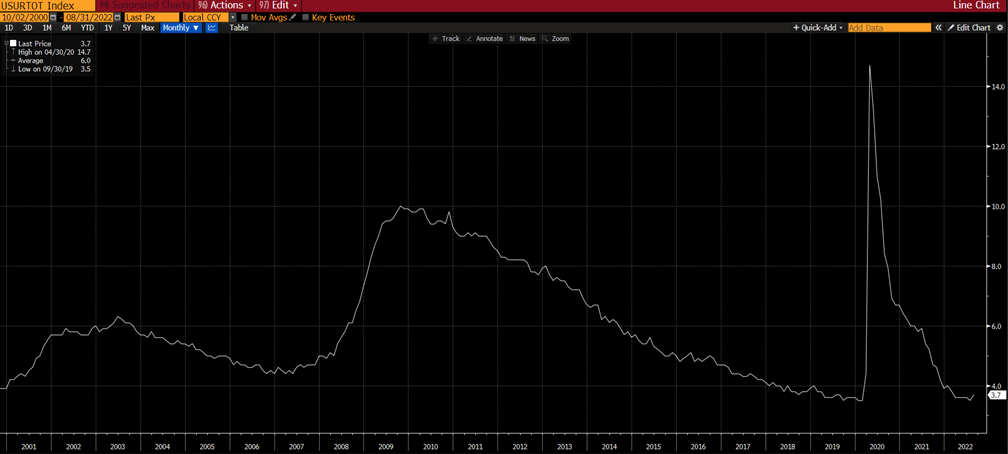Bear case fully made; where is the Bull? — Week of October 3, 2022

Strategy and Positioning written by Steve Orr, Chief Investment Officer; and Essential Economics written by Mark Frears, Investment Advisor
| index | wtd | ytd | 1-year | 3-year | 5-year | index level |
|---|---|---|---|---|---|---|
| S&P 500 Index | -2.88 | -23.88 | -15.49 | 8.59 | 9.21 | 3,585.87 |
| Dow Jones Industrial Average | -2.92 | -19.72 | -13.40 | 4.81 | 7.41 | 28,725.51 |
| Russell 2000 Small Cap | -0.82 | -25.12 | -23.53 | 4.95 | 3.52 | 1,664.72 |
| NASDAQ Composite | -2.68 | -31.99 | -26.23 | 11.11 | 11.28 | 10,575.62 |
| MSCI Europe, Australasia & Far East | -1.71 | -26.98 | -24.98 | -1.26 | -0.35 | 1,655.31 |
| MSCI Emerging Markets | -3.56 | -27.19 | -28.07 | -1.77 | -1.54 | 873.29 |
| Barclays U.S. Aggregate Bond Index | -0.69 | -14.35 | -14.34 | -3.21 | -0.21 | 2,017.22 |
| Merrill Lynch Intermediate Municipal | -0.94 | -10.19 | -9.78 | -1.42 | 0.65 | 287.50 |
As of market close September 30, 2022. Returns in percent.
Strategy & Positioning
— Steve Orr
Good riddance
We want to forget the third quarter, but how can we? And if we can erase the third quarter, why not just erase 2022 and start over? Is there a return desk for calendar years? Jim Bianco thinks this year is the worst for bond returns in over 3,000 years. It certainly is the worst since the beginning of bond index tracking. This is the fourth worst start for the S&P 500 in 90 years. Are things so bad that they are good? We think there is finally some light at the end of the tunnel.
Russian Bear
Ian and Ukrainian advances drove the headlines last week. Certainly, the storm damage and loss of life is traumatic. Storm repair is not a boost to the economy — the old broken window theory — they are a loss period. Redrawing battle lines in Ukraine may allow a better harvest and grain exports in the coming months. A bear market for the Russian invasion can only help Europe’s outlook. Yes, we know that a couple of Russian bombers were moved to a western base, but nothing in Putin’s speeches or the military’s readiness level suggests a new position on using nuclear weapons.
Bears closer to home enjoyed the Fed speakers out in force last week. Lest anyone think the FOMC is about to blink on raising rates, nine — yes, nine — Fed members spoke about raising rates. Two quotes stood out to us: “...recession won’t stop the Fed from raising rates” (Mester) and “not seeing progress on inflation yet” (Kashkari). The second one got our attention because on Sunday, September 25, Collins stated that “inflation may have peaked.” We would agree now that housing prices (outside of Texas) have dropped month-over-month, along with rents.
The Bear case remains war, sticky inflation and a determined Fed. All can gang up to squeeze margins and lower corporate earnings in the coming quarters. There have already been negative preannouncements from several heavyweights like Nike, Apple and FedEx. Have markets accounted for lower earnings? Friday’s close pushed forward price to earnings of the S&P 500 down 15.5 times. If earnings can hold in the $220 to $235 area, stocks could wage a good relative value fight against a 3.75% 10-year Treasury yield.
No Bull?
We always have a Bull case, although it may be hidden in our back pocket. Over the last three weeks, selling pressure in stocks has pushed technicals to extreme oversold levels, some to historic lows. The percentage of stocks above their moving averages are at levels of past bottoms. Relative strength and New Highs vs. New Lows are also near bottoming levels. The bounce Monday-Tuesday morning will do little to improve those metrics.
Typical in Bear cycles, the utility sector was holding up relatively well. It finally gave up and rolled over last week. When the last S&P sector gives up the ghost, usually a near-term bottom is close. Analysts are getting the hint that third quarter earnings are not going to be worth writing home about. They have a habit of overshooting both directions, which could give us an earnings season bounce in a couple of weeks.
Wrap-up
The fourth quarter is typically the best performer of a mid-term year. October historically has the best returns for stocks, and bonds do not fare badly either. Markets are badly oversold for both stocks and bonds and are due for a bounce. Will it be a bounce that kills the Bear? War, inflation, the Fed and lower Earnings (WIFE) complicate the otherwise strong seasonal pattern. Our indicators look to capture the intermediate and longer-term waves of the markets. As such, they are keeping us on the sidelines for now.
Essential Economics
— Mark Frears
Basics
This time of the year in Texas, you can take in football games on every level. Flag for the youngest kids. Junior Varsity on Thursday nights, and of course, Friday night lights. Colleges in every division. The Boys and Oilers, whoops, Texans on Sunday. Every coach is teaching basics — blocking, tackling, proper formation and teamwork. There is one basic observed at every level in economics — supply and demand.
Housing
We have all heard the stories, and may have experienced it firsthand, about offering thousands of dollars over the asking price of a house and not winning. That has been happening in the hot markets in big cities such as Denver and Seattle, as well as in smaller cities, such as Frisco, Texas.
Supply and demand. There are not enough houses in the desired locations and price ranges to satisfy increased demand. Some of this demand is brought on by low interest rates making it more affordable, and some by people looking for their next home, and some by corporations investing in what they see as a lucrative asset. On the supply side, the pandemic caused slower building due to labor and material shortages. Hence, the imbalance pushing prices higher.
While housing starts have been on a positive trend (see below), this may not be sustainable.

Source: Bloomberg
Building permits are still on a longer-term upward trend line, and with slowing demand, there may not be an incentive to build more right now.

Source: Bloomberg
Labor
As the Fed has raised rates, attempting to slow the economy, one area that seems to pay no mind is the labor sector. We continue to see nonfarm payroll monthly additions to the workforce of close to 400,000, no change from before the start of tightening. Also, the unemployment rate has stayed close to historic lows (see below).

Source: Bloomberg
Other indicators that point to more demand than supply are the initial jobless claims and the Job Openings report. The FOMC does not like this, as employers have to continue to “pay up” to retain and attract employees. This wage inflation will not help them slow down the economy and bring overall prices to their knees.
Ultimately, they would like to destroy job openings before they destroy jobs. We don’t need to see a negative nonfarm payroll release, but one that is more consistent with replacing existing jobs versus adding new ones.
Wrap-up
Getting back to basics is always a good thing. Look at the underlying reasons the economy is moving in the direction it is. The Fed is not happy with the current direction, and they will do all in their power to change it. Hope your team won last weekend!
| Upcoming Economic Releases: | Period | Expected | Previous | |
|---|---|---|---|---|
| 3-Oct | S&P Global US Manufacturing PMI | Sep | 51.8 | 51.8 |
| 3-Oct | Construction Spending MoM | Aug | -0.3% | -0.4% |
| 3-Oct | ISM Manufacturing | Sep | 52.1 | 52.8 |
| 3-Oct | ISM Prices Paid | Sep | 52.0 | 52.5 |
| 3-Oct | ISM New Orders | Sep | 50.5 | 51.3 |
| 3-Oct | ISM Employment | Sep | 53.0 | 54.2 |
| 3-Oct | Ward's Total Vehicle Sales | Sep | 13,550,000 | 13,180,000 |
| 4-Oct | Factory Orders | Aug | 0.2% | -1.0% |
| 4-Oct | JOLTS Job Openings | Aug | 11,075,000 | 11,239,000 |
| 5-Oct | ADP Employment Change | Sep | 200,000 | 132,000 |
| 5-Oct | Trade Balance | Aug | -$67.9B | -$70.7B |
| 5-Oct | S&P Global US Services PMI | Sep | 49.2 | 49.2 |
| 5-Oct | S&P Global US Composite PMI | Sep | 49.3 | 49.3 |
| 5-Oct | ISM Services Index | Sep | 56.0 | 56.9 |
| 6-Oct | Challenger Job Cuts YoY | Sep | N/A | 30.3% |
| 6-Oct | Initial Jobless Claims | 1-Oct | 205,000 | 193,000 |
| 6-Oct | Continuing Claims | 24-Sep | 1,380,000 | 1,347,000 |
| 7-Oct | Change in Nonfarm Payrolls | Sep | 250,000 | 315,000 |
| 7-Oct | Change in Private Payrolls | Sep | 300,000 | 308,000 |
| 7-Oct | Unemployment Rate | Sep | 3.7% | 3.7% |
| 7-Oct | Average Hourly Earnings MoM | Sep | 0.3% | 0.3% |
| 7-Oct | Average Weekly Hours | Sep | 34.5 | 34.5 |
| 7-Oct | Labor Force Participation Rate | Sep | 62.4% | 62.4% |
| 7-Oct | Underemployment Rate | Sep | N/A | 7.0% |
| 7-Oct | Wholesale Inventories MoM | Aug | 1.3% | 1.3% |
| 7-Oct | Consumer Credit | Aug | $25.000B | $23.811B |
Steve Orr is the Executive Vice President and Chief Investment Officer for Texas Capital Bank Private Wealth Advisors. Steve has earned the right to use the Chartered Financial Analyst and Chartered Market Technician designations. He holds a Bachelor of Arts in Economics from The University of Texas at Austin, a Master of Business Administration in Finance from Texas State University, and a Juris Doctor in Securities from St. Mary’s University School of Law. Follow him on Twitter here.
Mark Frears is an Investment Advisor at Texas Capital Bank Private Wealth Advisors. He holds a Bachelor of Science from The University of Washington, and an MBA from University of Texas – Dallas.
The contents of this article are subject to the terms and conditions available here.